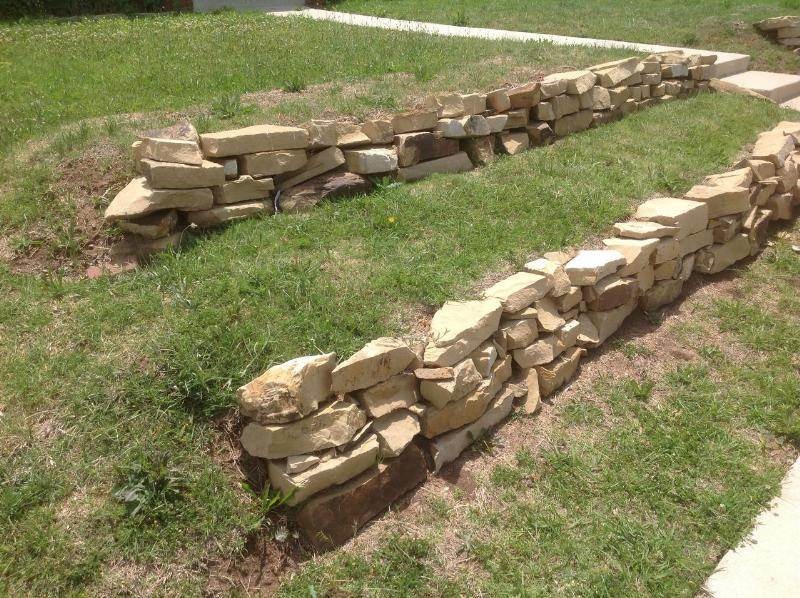Erosion – the displacement of soil from one place to the other – can happen on large properties and small. When soil from your yard runs into the street, it can block storm water systems. Erosion is unsightly at best and an environmental problem at worst. But you can do some simple things to protect your yard – and our environment – from erosion.
The best way to prevent erosion is by covering your soil. Bare soil is vulnerable to both wind and rain erosion. Soil needs to be covered year-round in order to be protected.

The way you landscape your yard depends on your preferences and your yard’s characteristics. If the slope of your yard is not very steep, grasses, shrubs, and mulches will collect rainfall and snowmelt. Grasses native to your region will help build soil stability. Native grasses grow long roots that tie the topsoil and subsoil together. Certain species of vegetative cover, like clover, have shallow roots and will not sufficiently stabilize your soil surface, especially on slopes. Woody shrubs are another effective type of soil mulch. Flowers and plants are also effective in preventing erosion, as well as bringing aesthetic value to your landscape.
If the goal for your yard is to establish a thriving, healthy garden, incorporate mulch on the soil surface around your various plants to help cover those bare soil surfaces. Mulch adds organic matter and increases moisture retention. Mulch helps regulate soil temperature while also preventing erosion in those sensitive areas. There are different types of mulch to use based on your geographic region and your yard’s soil chemistry.
Buffer strips, or swathes of native species, are a great way to reduce erosion and sedimentation. An added bonus is using plants that can attract pollinators and increase biodiversity. In prairie regions, native grasses can be thick and rough. Prairie grasses have stronger and deeper roots than lawn grasses. They also increase soil microbial activity which creates a healthier lawn. So if you live in these regions and have a large lawn, consider using a border of prairie grasses to help the environment.

Landowners with erosion issues on their steep-sloping lawns may need to use terracing and/or small retaining walls. These features add tremendous benefit by preventing erosion and loss of soil resources. Terracing is a method of slope control where the slope is shaped in a staircase pattern. You can use buffer strips of prairie grasses to terrace your lawn. Alternatively, you can use a brick or stone structure. Terracing creates a pattern of several feet of lawn grass rimmed with either a vegetative buffer, a brick or stone structure, or a retaining wall. For more ideas on how to terrace your property, check out this site that has great aesthetic designs.
Rainfall that comes from your roof can have a severe impact on soil erosion on your property. There are several ways to manage this water depending on local and state regulations. Rain collection barrels trap rainfall before it ever hits the soil surface. If you live in a state that does not allow rain collection barrels, consider French drains or rain gardens. These divert the water to designated areas in your lawn that are equipped with means of managed drainage. French drains are typically designed as perforated HDPE pipe that is surrounded by gravel. They allow filtered water into the pipe which is then carried off the property to a sewer system or drainage area. Rain gardens are essentially miniature wetlands. They are small areas that can remain wet, and support plant life that thrives in standing water or saturated soils. Rain gardens are ideal because they help filter water as it percolates into the soil profile down to the groundwater table. For more information about rain gardens, visit this site from Washington State University that highlights the basics and functions of the different types you can use in your yard.
If you are still experiencing erosion, ponding water, or poor vegetative cover due to saturated soils after implementing these steps, reach out to a soil scientist about the issue. Sometimes a more aggressive investigation is needed to identify what exactly is needed for proper infiltration and erosion control.
When we think of erosion, we tend to think about larger areas that have undergone land disturbance or larger areas that produce enormous volumes of sediment deposition. Erosion and sedimentation are common and happen frequently in these areas if they weren’t prepared for ahead of time. But smaller scale properties (like households and lawns) can experience erosion as well. By implementing best management practices in one’s yard, the chance of erosion occurring can be greatly decreased. Keeping your topsoil in place with these types of practices will help keep your lawns healthy and productive for vegetative growth.
By James Hartsig, CPSS, Duraroot
To receive notices about future blogs, be sure to subscribe to Soils Matter by clicking on the Follow button on the upper right! Explore more on our webpage About Soils. There you will find more information about Soil Basics, Community Gardens, Green Infrastructure, Green Roofs, Soil Contaminants, materials for Teachers and more.

Hi James,
Thanks for finding time to write about this issue of soil erosion.
As important as this is, few people talk about this. Most people would rather blog about the latest fashion in town than to talk about this.
Keep up the good work.
Dear Cato, we have passed your comment along to James. SF
Thanks, Cato. There is a lot of good information out there regarding easy, DIY options for erosion prevention.
Thanks for promoting our blog! SF